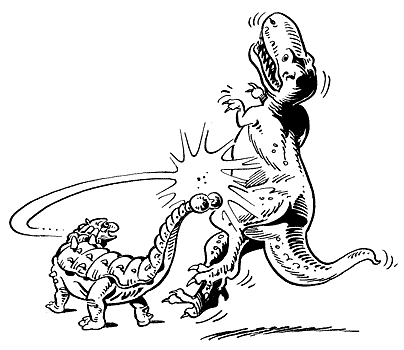sauro-, saur-, -saurus, -saurid, -saur,
-sauria, -saurian +
(Greek: lizard, reptile, serpent; used especially with reference to "dinosaurs")
Arctosaurus
An “arctic lizard” from Late Triassic Cameron Island, Canada, north of the Arctic Circle. Named by Andrew Leith Adams in 1875.
Argentinosaurus
A “silver (Argentina) lizard” or “Argentine lizard” from Late Cretaceous Argentina and Uruguay. It was found in the Rio Limay Formation, Neuquen Province, Argentina. Named by Argentinian paleontologists José F. Bonaparte and Rodolfo Coria in 1993.
Argyrosaurus
A “silver lizard” from Late Cretaceous Uruguay and Argentina (“land of silver”). Named by British paleontologist Richard Lydekker in 1893.
Aristosaurus
Means “best (specimen) lizard” from Late Triassic or Early Jurassic South Africa. Its name alludes to the preservation of the fossil; one of the Transvaal Museum’s best specimens, a nearly complete skeleton. Named by van Hoepen in 1920. It is now considered “an invalid name” for Massospondylus, a herbivorous Saurischian dinosaur from the late Triassic period.
Arkansaurus
Means “Arkansas lizard” from fossils found in Arkansas, USA. Named by paleontologist W. Bernhard Sattler in 1983.
Arstanosaurus
Means “Arstan lizard” from Late Cretaceous Arstan Well area in Kazakhstan. Named by Yu V. Suslov and Peter V. Shilin in 1982.
Asiatosaurus
“Asian lizard” from Early Cretaceous rocks of Ovorkhangai, Mongolia, and China. Named by U. S. paleontologist Henry Fairfield Osborn in 1924.
Atlantosaurus
“Atlas lizard” named for a giant in Greek myth from Late Jurassic Colorado, USA. Named by Othniel Charles Marsh (1831-1899) in 187
7. Some say it may be an Apatosaurus.
7. Some say it may be an Apatosaurus.
Atlascopcosaurus
“Atlas Copco lizard” from Early Cretaceous Australia. Named for the Atlas Copco Corporation that supplied pneumatic tools and accessory equipment which enabled the excavations at Dinosaur Cove, Queensland, Australia. Named by Thomas Rich and Patricia Vickers-Rich in 1989.
Attenborosaurus
“Attenborough’s lizard” from Early Jurassic Europe. Named for naturalist and filmmaker, David Attenborough. The fossil was found in Charmouth, England, and kept in the collection of the Bristol City Museum. Named by Robert T. Bakker in 1993.
One of the diverse carnivorous dinosaurs of the genus Allosaurus; "southern lizard": Austrosauruses existed from the Early-Middle Cretaceous of Central Western Queensland, Australia. Austrosaurus was named by the paleontologist J. Heber Longman in 1933.
Azendohsaurus
“Azendoh lizard” from Late Triassic Azendoh village in Morocco’s Atlas Mountains in the region of Marrakesh. Named by paleontologist J. M. Dutuit in 1972.
Bactrosaurus
“Club (spined) lizard” from Late Cretaceous Mongolia. Its name is said to come from Greek baktron, “rod, staff, club”. The name Bactrosaurus is often misinterpreted as “Bactrian lizard”; however, ancient Bactria was in southwest Asia, far from Chinese Inner Mongolia where the original fossil was found. Named by U. S. paleontologist Charles Whitney Gilmore in 1933.

The artist’s conceptions of dinosaur actions, and reactions,
may be just as legitimate as those of scientists in many cases.

may be just as legitimate as those of scientists in many cases.
Bahariasaurus
“Baharije (oasis) lizard” from Late Cretaceous period and found in northern Egypt and Algeria. It was named for the Baharija Formation, Egypt, where the fossil was found. Named by German paleontologist Ernst Stromer von Reichenbach in 1934.
Barapasaurids
A possible name for the family to which Barapasaurus dinosaurs belonged.


